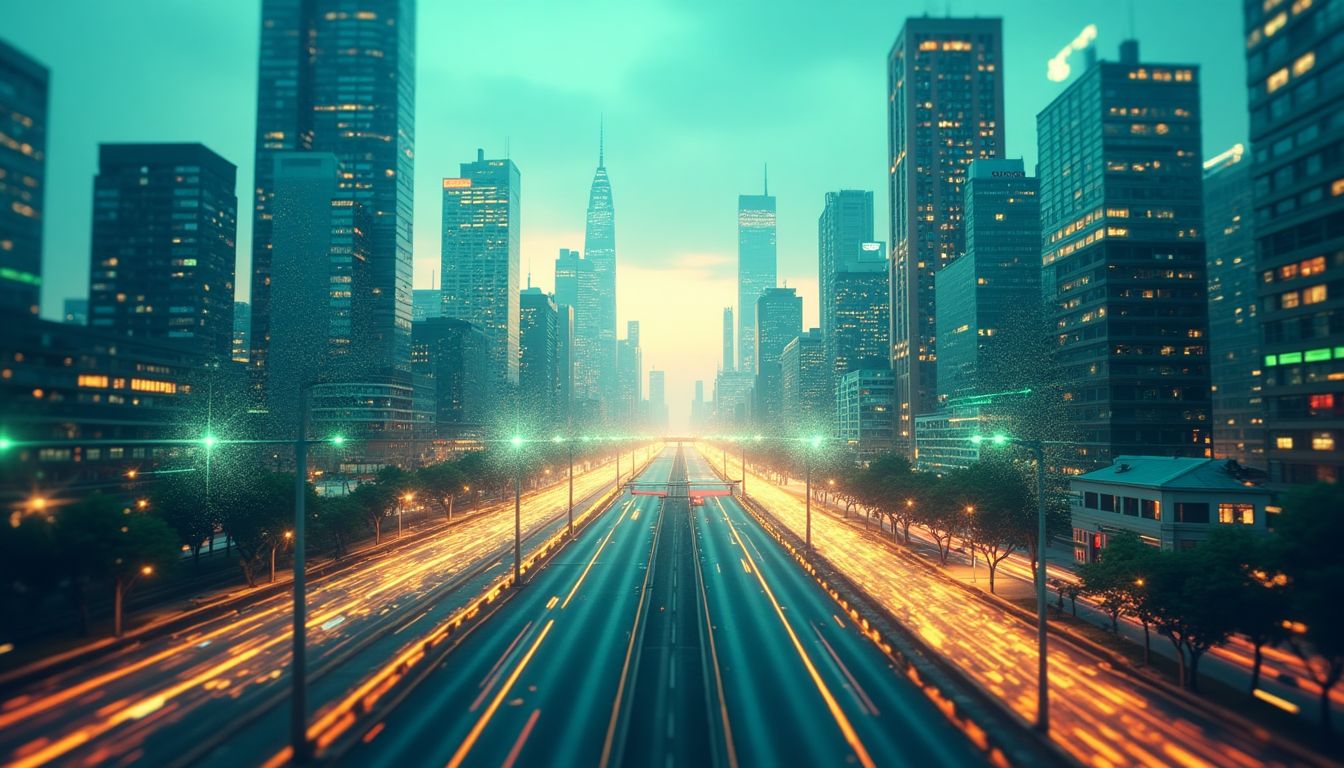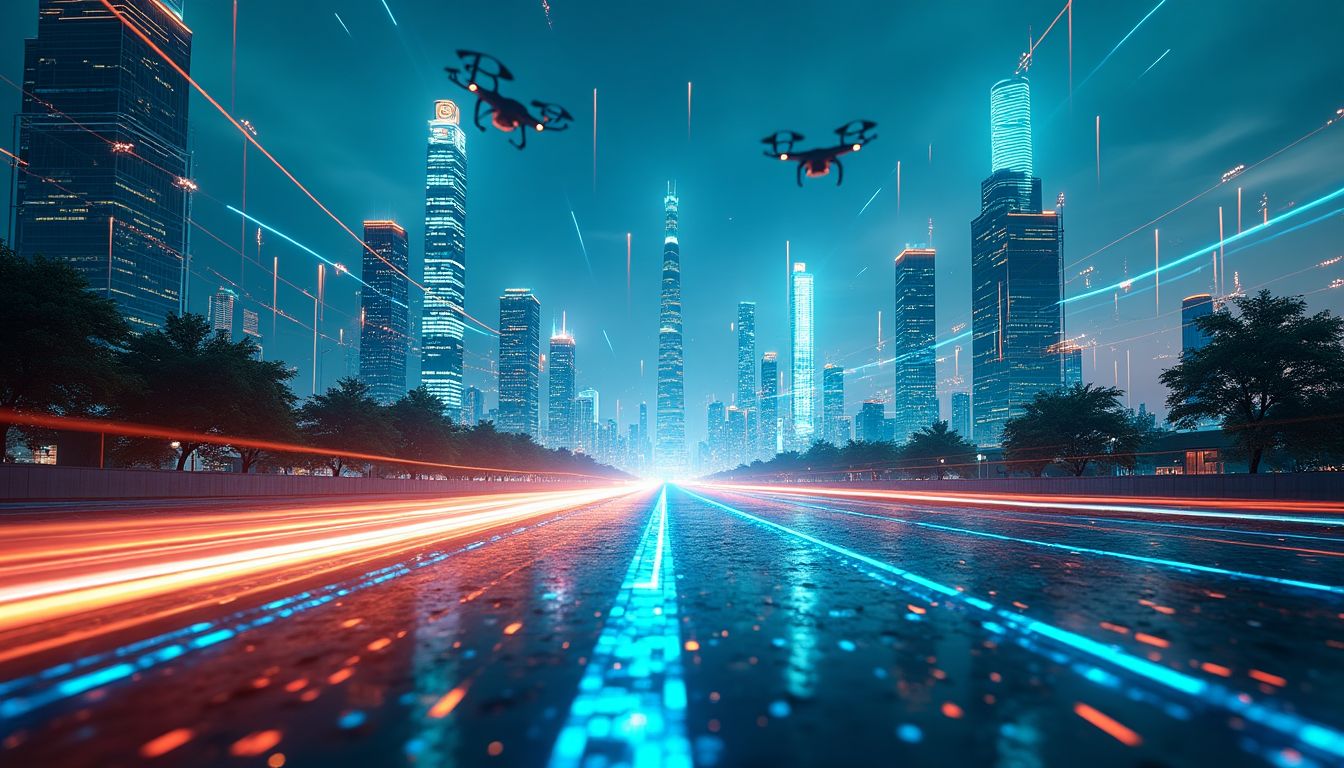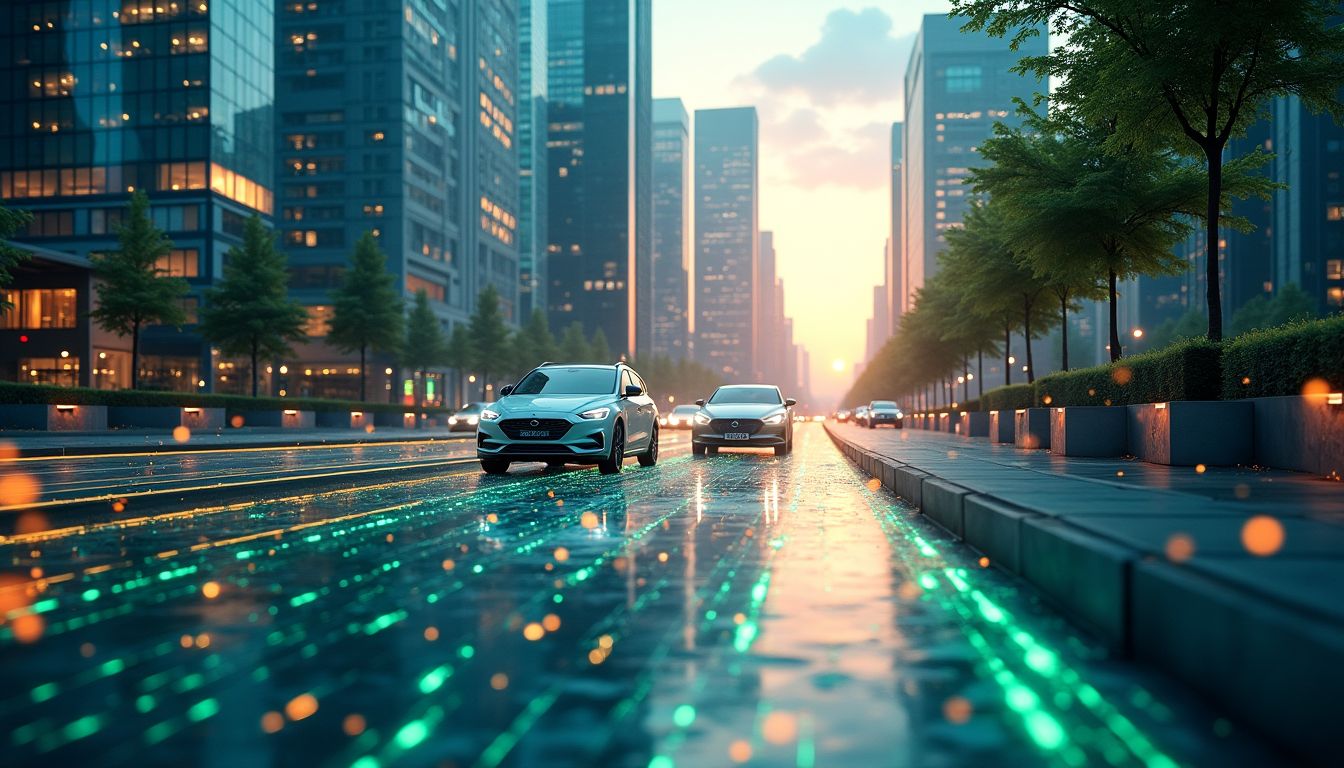What if your morning commute was as smooth as butter, your energy bill shrank by 30%, and your city knew exactly when to collect your trash without you ever lifting a finger? Welcome to the world of AI-powered smart cities, where urban living is no longer a chaotic mess but a finely tuned symphony of efficiency. As cities grow denser and more complex, the need for smarter solutions has never been greater. Enter Artificial Intelligence (AI), the unsung hero of modern urban planning, ready to tackle everything from traffic jams to energy waste with the precision of a Swiss watch.
By 2050, nearly 70% of the world’s population will call cities home, according to the United Nations. That’s a lot of people crammed into limited space, putting immense pressure on infrastructure, resources, and patience. But AI is here to save the day. Think of it as the ultimate urban planner, crunching data from sensors, cameras, and even your smartphone to make cities smarter, greener, and more livable. From Singapore’s Smart Nation initiative to Barcelona’s Digital City project, AI is already transforming urban landscapes.
Renowned futurist Ray Kurzweil once predicted that AI would surpass human intelligence by 2045. While we’re not quite there yet, AI is already making waves in urban management. MIT’s Senseable City Lab, led by Carlo Ratti, has been at the forefront of this revolution, exploring how AI can optimize everything from traffic flow to waste management. Meanwhile, Fei-Fei Li, a pioneer in computer vision, has shown how AI can “see” and interpret urban environments in ways that were once the stuff of science fiction.
But what exactly makes a city “smart”? And why is AI the secret sauce that ties it all together? Let’s dive in and explore how AI is reshaping urban living, one algorithm at a time.
1. The Rise of Smart Cities and the Role of AI
1.1 What Are Smart Cities?
Smart cities are urban areas that use technology to improve the quality of life for their residents. Think of them as cities on steroids, where everything from traffic lights to trash bins is connected to the internet and powered by data. The goal? To make cities more efficient, sustainable, and livable. Key components include the Internet of Things (IoT), big data, AI, and citizen engagement. Together, these technologies create a dynamic ecosystem that can adapt to the needs of its inhabitants in real time.
Take Singapore, for example. This tiny island nation has become a global leader in smart city innovation. From AI-powered traffic management to smart water systems, Singapore is a living lab for urban tech. Similarly, Barcelona has transformed itself into a digital city, using IoT sensors to monitor everything from air quality to parking spaces. And let’s not forget Amsterdam, where smart grids and energy-efficient buildings are the norm.
1.2 Why AI is the Backbone of Smart Cities
AI is the brain behind the smart city. Without it, all those sensors and data streams would be just noise. AI’s ability to process vast amounts of data in real time and make predictions is what makes smart cities truly “smart.” For instance, AI can analyze traffic patterns to predict congestion before it happens, or it can optimize energy grids to balance supply and demand. It’s like having a crystal ball for urban planning.
Singapore’s Smart Nation initiative is a prime example of AI in action. The city-state uses AI to monitor everything from public transportation to healthcare, creating a seamless experience for its residents. And it’s not just about efficiency—AI can also improve safety. For example, AI-powered cameras can detect accidents or suspicious activity in real time, allowing authorities to respond quickly.
1.3 Challenges in Urban Management Without AI
Without AI, cities are like ships without a rudder—directionless and prone to chaos. Traffic congestion, pollution, and inefficiencies in resource allocation are just a few of the challenges cities face. Traditional urban planning methods, while effective in their time, simply can’t keep up with the pace of modern urbanization. For example, manually adjusting traffic lights or waste collection routes is time-consuming and often ineffective.
Consider Los Angeles, a city notorious for its traffic jams. Before implementing AI-powered traffic management systems, commuters spent hours stuck in gridlock. But with AI, the city has been able to reduce congestion and improve traffic flow. Similarly, cities like Cape Town have used AI to manage water resources during droughts, ensuring that residents have access to clean water even in times of scarcity.
2. AI in Transportation: Revolutionizing Urban Mobility
2.1 Real-Time Traffic Management
Picture this: you’re stuck in traffic, late for work, and the light ahead has been red for what feels like an eternity. Now imagine that same light, powered by AI, adjusting in real time to keep traffic flowing smoothly. Sounds like magic, right? It’s not—it’s the future of urban mobility. AI-powered traffic management systems, like the one in Los Angeles’ ATSAC system, use sensors and cameras to monitor traffic flow and adjust signals dynamically. The result? Fewer jams, less honking, and more time for coffee breaks.
But it doesn’t stop there. AI can also predict traffic patterns before they happen. By analyzing historical data and real-time inputs, AI models can forecast congestion hotspots and reroute traffic before gridlock sets in. Think of it as a weather forecast for your commute—except instead of rain, you’re dodging traffic Armageddon.
2.2 Autonomous Vehicles and Public Transit
Self-driving cars aren’t just for sci-fi movies anymore. Companies like Waymo are already testing autonomous taxis in cities like Phoenix, Arizona. These AI-driven vehicles use a combination of sensors, cameras, and machine learning to navigate streets safely and efficiently. And it’s not just cars—AI is also transforming public transit. Imagine buses that adjust their routes based on real-time demand, or trains that predict maintenance needs before they break down. It’s like having a personal chauffeur for an entire city.
AI is also making public transit smarter. By analyzing ridership data, AI can optimize bus and train schedules to reduce wait times and overcrowding. For example, cities like Helsinki are experimenting with on-demand transit systems that use AI to match riders with the most efficient routes. It’s like Uber, but for buses—and way cheaper.
2.3 Reducing Emissions and Enhancing Safety
Traffic isn’t just annoying—it’s also a major source of pollution. AI is stepping up to tackle this problem too. By optimizing traffic flow and reducing idling time, AI can significantly cut down on vehicle emissions. Some cities are even using AI to monitor air quality in real time and adjust traffic patterns accordingly. It’s like giving the planet a breath of fresh air.
Safety is another area where AI shines. Predictive maintenance systems use AI to monitor the health of public transit vehicles, catching issues before they become accidents. And AI-driven collision avoidance systems are making roads safer for everyone. For example, Tesla’s Autopilot uses AI to detect potential hazards and take corrective action. It’s like having a guardian angel for your car.
3. AI in Energy Management: Powering Cities Efficiently
3.1 Smart Grids and Energy Distribution
Ever wondered how your city keeps the lights on? The answer lies in the power grid—a complex network of power plants, transmission lines, and substations. But as cities grow, so does the demand for energy. Enter AI-powered smart grids. These systems use real-time data to balance supply and demand, ensuring that energy is distributed efficiently and reliably. For example, Texas’ ERCOT grid uses AI to predict energy demand and adjust supply accordingly. It’s like having a DJ for the power grid, mixing energy sources to keep the party going.
AI also plays a crucial role in predictive maintenance. By analyzing data from sensors embedded in the grid, AI can detect potential failures before they happen. This not only prevents blackouts but also saves cities millions in repair costs. It’s like having a crystal ball for your power lines.
3.2 Renewable Energy Integration
Renewable energy is the future, but it comes with its own set of challenges. Solar and wind power are great, but they’re also unpredictable—what happens when the sun doesn’t shine or the wind doesn’t blow? AI has the answer. By analyzing weather patterns and energy production data, AI can optimize the use of renewable energy sources. For example, Google’s DeepMind reduced energy use in its data centers by 40% using AI. That’s like powering a small city with just a few lines of code.
AI is also revolutionizing energy storage. By predicting energy demand and supply, AI can optimize the charging and discharging of batteries, ensuring that renewable energy is available when it’s needed most. It’s like having a giant battery pack for your city, ready to go at a moment’s notice.
3.3 Citizen Engagement in Energy Conservation
AI isn’t just for city planners—it’s also for citizens. AI-powered apps can provide real-time feedback on energy usage, helping people make smarter choices about how they use power. For example, apps like Opower use AI to compare your energy use with your neighbors’, encouraging friendly competition to save energy. It’s like a game show, but instead of winning a prize, you save the planet.
Gamification is another powerful tool for energy conservation. By turning energy-saving behaviors into a game, AI can motivate people to reduce their energy use. For example, some cities are experimenting with apps that reward users with points for turning off lights or lowering the thermostat. It’s like earning badges in a video game, but with real-world benefits.
4. AI in Water and Waste Management: Sustainable Urban Living
4.1 Smart Water Systems
Water is the lifeblood of any city, but managing it efficiently is a growing challenge. AI is stepping in to revolutionize how cities handle water resources. From detecting leaks to predicting water demand, AI-powered systems are making water management smarter and more sustainable.
For example, Cape Town faced a severe drought in 2018, but AI helped the city avoid "Day Zero" by predicting water usage patterns and optimizing distribution. AI algorithms analyzed data from smart meters and weather forecasts to ensure water was allocated where it was needed most.
Key applications of AI in water management include:
- Leak Detection: AI can analyze data from sensors to identify leaks in real time, saving millions of gallons of water annually.
- Water Quality Monitoring: AI systems can detect contaminants and ensure safe drinking water for citizens.
- Predictive Analytics: By forecasting water demand, AI helps cities plan for droughts and other emergencies.
4.2 Waste Management Optimization
Waste management is another area where AI is making a big impact. Traditional waste collection methods are often inefficient, leading to overflowing bins and unnecessary emissions. AI is changing the game by optimizing waste collection routes and automating recycling processes.
In Seoul, AI-powered smart bins monitor waste levels and send alerts when they need to be emptied. This reduces the number of collection trips, cutting down on fuel use and emissions. AI also helps sort recyclables more efficiently, reducing contamination and increasing recycling rates.
Here’s how AI is transforming waste management:
- Route Optimization: AI algorithms calculate the most efficient routes for waste collection trucks, saving time and fuel.
- Smart Bins: Sensors in bins notify waste management teams when they’re full, preventing overflow and reducing collection frequency.
- Recycling Automation: AI-powered robots can sort recyclables faster and more accurately than humans.
4.3 Circular Economy and AI
The concept of a circular economy—where resources are reused and recycled—is gaining traction, and AI is playing a key role in making it a reality. By tracking resource flows and identifying opportunities for reuse, AI helps cities reduce waste and create sustainable systems.
For instance, AI can analyze data from manufacturing processes to identify waste materials that can be repurposed. This not only reduces landfill use but also creates new economic opportunities. Cities like Amsterdam are already using AI to promote circular economy initiatives, from recycling construction materials to optimizing food waste management.
Key benefits of AI in the circular economy include:
- Resource Tracking: AI monitors the lifecycle of materials, ensuring they’re reused or recycled efficiently.
- Waste Reduction: Predictive analytics help cities minimize waste by identifying patterns and trends.
- Economic Opportunities: AI-driven insights create new markets for recycled materials and products.
5. Ethical and Social Implications of AI in Smart Cities
5.1 Data Privacy and Security
While AI offers incredible benefits, it also raises serious concerns about data privacy and security. Smart cities rely on vast amounts of data collected from sensors, cameras, and citizen interactions. This data is often personal and sensitive, making it a prime target for cyberattacks.
For example, in 2021, a ransomware attack on Colonial Pipeline disrupted fuel supplies across the U.S., highlighting the vulnerabilities of critical infrastructure. To prevent similar incidents, cities must implement robust cybersecurity measures and ensure transparency in how data is collected and used.
Key considerations for data privacy and security include:
- Encryption: Protecting data with advanced encryption techniques.
- Transparency: Clearly communicating how data is used and stored.
- Accountability: Establishing clear guidelines for data access and usage.
5.2 Equity and Accessibility
AI has the potential to improve urban living, but it must be accessible to all citizens. Without careful planning, AI-driven systems could exacerbate existing inequalities, leaving marginalized communities behind.
For instance, AI-powered public transit systems might prioritize affluent neighborhoods, leaving low-income areas underserved. To avoid this, cities must ensure that AI benefits everyone, regardless of socioeconomic status. This includes investing in infrastructure in underserved areas and involving citizens in the planning process.
Strategies for promoting equity and accessibility include:
- Inclusive Design: Developing AI systems that serve all citizens, including those with disabilities.
- Community Engagement: Involving citizens in decision-making to ensure AI solutions meet their needs.
- Affordable Access: Providing low-cost or free access to AI-powered services for low-income residents.
5.3 Governance and Regulation
As AI becomes more integrated into urban life, the need for effective governance and regulation grows. Without proper oversight, AI systems could be misused or cause unintended harm. Governments must strike a balance between fostering innovation and protecting citizens’ rights.
For example, the European Union’s AI Regulation Framework sets strict guidelines for AI development and deployment, ensuring transparency and accountability. Cities must adopt similar frameworks to ensure AI is used ethically and responsibly.
Key elements of effective AI governance include:
- Ethical Guidelines: Establishing principles for responsible AI use.
- Regulatory Oversight: Creating agencies to monitor and enforce AI regulations.
- Public Accountability: Ensuring citizens have a voice in how AI is used in their communities.
6. AI Solutions: How Would AI Tackle These Issues?
6.1 Step-by-Step AI Implementation
Implementing AI in smart cities isn’t just about deploying fancy algorithms—it’s about creating a seamless, interconnected ecosystem that learns, adapts, and evolves. Here’s a step-by-step guide to making it happen:
- Data Collection: Deploy IoT sensors, cameras, and drones across the city to gather real-time data on traffic, energy use, water flow, and waste. For example, Siemens has already pioneered IoT solutions for urban infrastructure.
- Data Integration: Use AI platforms like IBM Watson to unify data streams into a centralized platform for analysis. This ensures that every piece of data is actionable.
- Predictive Modeling: Develop machine learning models to predict traffic patterns, energy demand, and resource needs. For instance, Google DeepMind has successfully reduced energy consumption in data centers by 40% using predictive analytics.
- Real-Time Optimization: Implement AI algorithms to adjust traffic lights, energy grids, and waste collection routes dynamically. Cities like Los Angeles have already seen significant improvements with adaptive traffic control systems.
- Citizen Engagement: Create AI-powered apps to inform and involve citizens in resource conservation efforts. Gamification, like Opower’s energy-saving challenges, can drive behavioral change.
6.2 Scientific and Technical Approaches
To make AI work in smart cities, we need cutting-edge scientific and technical approaches:
- Reinforcement Learning: Use reinforcement learning for adaptive traffic control, where AI systems learn from real-time feedback to optimize traffic flow. MIT’s Senseable City Lab has been a pioneer in this field.
- Deep Learning: Apply deep learning for energy demand forecasting, enabling cities to balance supply and demand efficiently. Stanford University has developed advanced models for this purpose.
- Computer Vision: Leverage computer vision for waste sorting automation, reducing human error and increasing recycling rates. Companies like AMP Robotics are leading the charge.
6.3 Case Studies and References
Real-world examples show the transformative power of AI in urban management:
- Singapore’s Smart Nation Initiative: Singapore uses AI to optimize everything from traffic to healthcare. Learn more about their approach on their official website.
- Barcelona’s Superblocks: Barcelona has implemented AI-driven urban planning to reduce traffic and pollution. Check out their city council website for details.
- Amsterdam’s Circular Economy: Amsterdam uses AI to track and optimize resource reuse, creating a sustainable urban ecosystem. Visit their official portal for insights.
6.4 Action Schedule/Roadmap (Day 1 to Year 2)
Here’s a detailed roadmap for implementing AI in smart cities, inspired by the precision of the Manhattan Project but tailored for today’s technology:
| Timeline | Action | Key Players |
|---|---|---|
| Day 1 | Assemble a multidisciplinary team of AI experts, urban planners, and policymakers. | Andrew Ng, Fei-Fei Li, and local government officials. |
| Day 2 | Conduct a city-wide audit of existing infrastructure and data systems. | Consultants from McKinsey & Company and BCG. |
| Week 1 | Begin deploying IoT sensors and cameras in key areas. | Engineers from Siemens and Honeywell. |
| Week 2 | Develop a centralized data platform for real-time analysis. | Data scientists from IBM and Microsoft. |
| Month 1 | Train machine learning models using historical data. | Researchers from MIT and Stanford. |
| Month 2 | Pilot AI-powered traffic management in one district. | Urban planners and Waymo engineers. |
| Year 1 | Expand AI systems to cover 50% of the city. | Collaboration between Google and local municipalities. |
| Year 1.5 | Launch citizen engagement apps and gamification programs. | Developers from Opower and Uber. |
| Year 2 | Achieve full-scale implementation, with AI optimizing all major urban systems. | Global consortium of tech giants, universities, and governments. |
The Future of AI-Driven Smart Cities
Imagine a city where the streets hum with efficiency, the air is clean, and resources are used wisely. This isn’t a utopian dream—it’s the future AI can help us build. By integrating AI into urban systems, we can tackle the challenges of rapid urbanization head-on, creating cities that are not only smart but also sustainable and equitable.
However, the journey won’t be easy. It will require collaboration between governments, tech companies, and citizens. It will demand transparency, ethical considerations, and a commitment to inclusivity. But the rewards—cleaner air, smoother commutes, and a better quality of life—are worth the effort.
As we stand on the brink of this urban revolution, one question remains: Are we ready to embrace the power of AI to shape the cities of tomorrow? The answer lies in our willingness to innovate, adapt, and work together. The roadmap is clear, the tools are available, and the time to act is now.
What kind of city do you want to live in? Share your thoughts in the comments below, and let’s build the future together. Don’t forget to subscribe to our newsletter for more insights and become a permanent resident of iNthacity: the "Shining City on the Web".
FAQ
1. What is a smart city?
A smart city uses technology like Artificial Intelligence (AI) and Internet of Things (IoT) to make urban living better. It helps manage resources like energy, water, and transportation more efficiently. Think of it as a city that learns and adapts to make life easier for everyone.
2. How does AI reduce traffic congestion?
AI uses real-time data from sensors and cameras to predict traffic jams before they happen. It can adjust traffic lights, reroute buses, and even guide self-driving cars to avoid bottlenecks. For example, Los Angeles uses an AI system called ATSAC to keep traffic flowing smoothly.
3. Can AI help with energy conservation?
Absolutely! AI can balance energy supply and demand in real time, making sure we don’t waste electricity. It also helps integrate renewable energy sources like solar and wind. For instance, Google’s DeepMind reduced energy use in their data centers by 40% using AI.
4. What are the risks of AI in smart cities?
While AI has many benefits, there are risks too. These include:
- Data Privacy: AI systems collect a lot of personal data, which could be misused if not protected.
- Bias in Algorithms: AI might unintentionally favor certain groups over others if not designed carefully.
- Accessibility: Not everyone might have equal access to AI-driven services, creating a digital divide.
5. How long does it take to implement AI in a city?
It depends on the city’s size and existing infrastructure, but typically, full implementation can take 1-2 years. Here’s a rough timeline:
| Phase | Timeframe |
|---|---|
| Planning and Team Assembly | Day 1 |
| Deploying IoT Sensors | Week 1 |
| Pilot AI Systems | Month 2 |
| Full Implementation | Year 2 |
6. Which cities are leading the way in AI-powered smart cities?
Some cities are already ahead of the curve:
- Singapore: Uses AI for everything from traffic management to healthcare.
- Barcelona: Known for its smart water and waste management systems.
- Amsterdam: Focuses on energy efficiency and citizen engagement.
7. How does AI improve public transportation?
AI can optimize bus and train routes, predict delays, and even manage autonomous vehicles. For example, Waymo is testing self-driving taxis in Phoenix, Arizona, which could revolutionize how we think about public transit.
8. What role do citizens play in smart cities?
Citizens are at the heart of smart cities. AI-powered apps can give real-time feedback on energy use, suggest greener transportation options, and even gamify recycling efforts. The more engaged citizens are, the smarter the city becomes.
9. Can AI help during natural disasters?
Yes! AI can predict disasters like floods or earthquakes, optimize emergency response routes, and even manage resources like water and electricity during crises. For example, during Cape Town’s drought, AI helped manage water usage to avoid a crisis.
10. What’s the future of AI in smart cities?
The future is bright! AI will continue to evolve, making cities more efficient, sustainable, and livable. Imagine a world where your city knows you better than you know yourself—anticipating your needs and solving problems before they arise. That’s the power of AI in smart cities.
Wait! There's more...check out our gripping short story that continues the journey: The Ouroboros Protocol
Disclaimer: This article may contain affiliate links. If you click on these links and make a purchase, we may receive a commission at no additional cost to you. Our recommendations and reviews are always independent and objective, aiming to provide you with the best information and resources.
Get Exclusive Stories, Photos, Art & Offers - Subscribe Today!





























Post Comment
You must be logged in to post a comment.